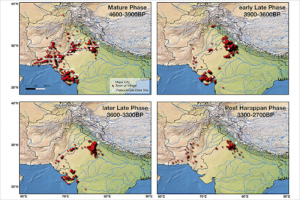What happened?
- The Indus River Valley Civilization, also known as the Harappan Civilization, was one of the three early civilizations in northwestern South Asia, along with Egypt and Mesopotamia. It was located in what is now Pakistan and northwestern India.
- This civilization existed between 3300 and 1300 BCE, with some cities reaching a population of 60,000 at their peak from c. 2600 to 1900 BCE. The Harappan people traded with Mesopotamian cities, built complex infrastructure with sewage systems, and had their own form of writing. They relied heavily on the flooding of the Indus River for crop irrigation and agriculture, and they built wells, drains, channels and dams to control the river water.
- Around 2500 BCE, civilization in the Indus River Valley began to decline as people migrated eastward to the Himalayan foothills. Here, they shifted from a civilization composed of large cities to one of mostly small farming villages (map below). By 1800 BCE, most Harappan cities were almost completely abandoned. Eventually, the villages in the foothills declined too.

Maps of the settlements of the Indus River Valley Civilization over time. Red dots represent towns and villages and white dots represent major cities. Notice how civilizations migrated east and how the number of cities decreased over time. Note that the years on the map are in years BP rather than BCE (BP = years before present; years BP = years BCE + 2000 years) (from Nield 2020).
How is this related to climate?
- Around 2500 BCE, the intensity of summer monsoons in the Indus River Valley began to decrease, causing droughts and making agriculture difficult for a society that relied heavily on floods for irrigation.
- People migrated to the foothills of the Himalayas where winter monsoons brought reliable rainfall, until they too dried up, leading to the ultimate demise of the civilization.
- Climate alone was probably not the cause of the fall of the Indus River Valley Civilization, but it was a very likely contributor. At the time, Indo-Aryan people were moving into the region and may have driven the Harappan people out.
- The changes in monsoon cycles may have been driven by colder air from the Arctic moving southward into the Atlantic and northern Europe. As a result, storms in the region shifted southward into the Mediterranean Sea, increasing the intensity of winter monsoons in the Indus River Valley. This may have also affected summer monsoons in the Indus River Valley, causing them to decrease in intensity.
Further Exploration
- The rise of the Indus River Civilization may also be attributed to monsoon cycles, as there is evidence for weaker monsoons and less run-off from the mountains around the time that the civilization was established.
- Researchers have a couple different pieces of evidence for climate as the cause of Harappan Civilization decline.
- In a recent study, researchers looked at the isotopic concentrations of stalagmites on the floor of a cave in the region (location marked with a white star on the maps above). These data allowed the researchers to generate a pattern of rainfall over the past 5,700 years. By analyzing this pattern, they concluded that summer monsoons may have begun to decline, leading to increased droughts, around the same time that the Harappan Civilization declined.
- Researchers have also analyzed sediment cores from the bottom of the Arabian Sea at the mouth of the Indus River. This is an oxygen-poor, or anoxic environment, so evidence of life is well-preserved as organic matter in the sediment. Winter monsoon winds bring nutrients to the surface of the sea, leading to a surge in plant and animal life. By looking at the sediment cores, researchers were able to determine when monsoons occurred and their intensity by looking at the amount of organic matter preserved in the sediment.
References and Additional Resources
- “Ancient Indus Valley Civilization & Climate Changes Impact.” Woods Hole Oceanographic Institution. 2018. https://www.whoi.edu/press-room/news-release/climate-change-likely-caused-migration-demise-of-ancient-indus-valley-civilization/.
- Lieberman, B. and Gordon, E. Climate change in human history: prehistory to the present. London, Bloomsbury Academic, 2018.
- Malik, N. “Uncovering Transitions in Paleoclimate Time Series and the Climate Driven Demise of an Ancient Civilization.” Chaos: An Interdisciplinary Journal of Nonlinear Science, vol. 30, no. 8, 2020, DOI: 10.1063/5.0012059.
- Nield, D. “Math Shows How Famed Indus Valley Civilization May Have Been Toppled by Climate Change.” Science Alert. 2020. https://www.sciencealert.com/maths-shows-how-an-ancient-civilisation-was-toppled-by-climate-change.
- Rochester Institute of Technology. “New mathematical method shows how climate change led to fall of ancient civilization: Researcher applies method to Indus Valley Civilization.” ScienceDaily. 2020. www.sciencedaily.com/releases/2020/09/200903105605.htm.
